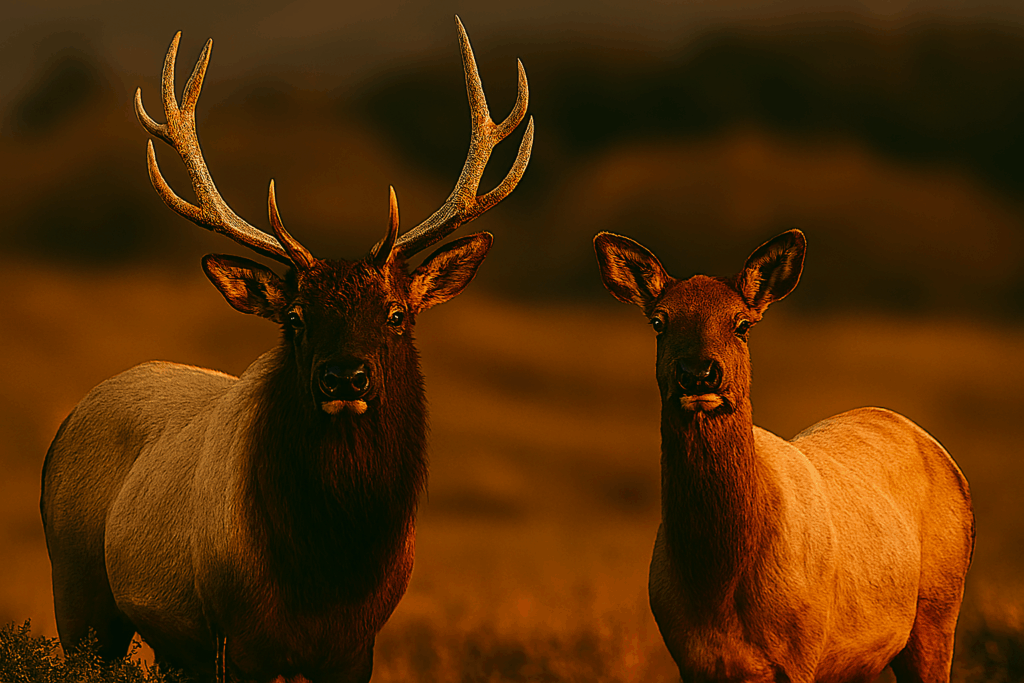Tule Elk Hunting Tips
Tule Elk Hunting Tips provide essential knowledge for anyone seeking success in the unique marshes and grassy valleys of California. This guide covers key strategies for locating and approaching Tule elk, understanding their behavior, and preparing for the challenging conditions these hunts demand. With these Tule Elk Hunting Tips, you’ll be ready to navigate wetlands, plan efficient stalks, and take advantage of public land opportunities for a rewarding hunt.

Biology and Physical Characteristics
Tule elk are California’s distinctive giants, named for the tule marshes where they first thrived. Bulls weigh anywhere from 450 to 700 pounds, carrying antlers that can arch over two feet with a graceful sweep. Cows tip the scales at 350 to 450 pounds, their slender necks and smooth hides adapted to marsh grasses and sedges. In summer their coats gleam tawny gold, fading to a darker brown in winter when dense underfur keeps them warm against coastal chills. Their hooves are narrower than other elk subspecies, perfectly designed for soft, muddy terrain. Inside, their four-chambered stomachs labor to break down tough marsh plants, and they ruminate for hours, processing every mouthful of wetland forage.
Habitat and Geographic Range
Tule elk occupy a patchwork of reserves, ranch lands, and protected wetlands from Point Reyes north of San Francisco up to the Central Valley escapes around Merced. They haunt grasslands, coastal scrub, and marsh edges, grazing where freshwater seeps into saltwater tidal flats. In dry months they wander oak woodlands and rolling hills to find spring-fed seeps and green flushes of grass. These elk use every inch of flat and low-slope country, sliding through thick willows and tule reeds that would choke larger-hoofed species. To find them, hunters must learn the marsh pathways and ridgelines, where elk slip like ghosts between water channels and grassy ledges.
Behavior and Hunting Challenges
Tule elk form tight cow–calf herds led by dominant cows, while bulls break into bachelor groups outside the rut. When autumn’s cool winds blow in, bulls shed bachelorhood and challenge each other in muddy wallows, bugling with a deep, resonant call that echoes across open meadows. Their bugles carry far but give away position, and unexpected echoes off ridges can send hunters on wild goose chases. These elk are wary of scent in open country, so any wrong move on soggy trails can alert entire herds. Rainy mornings turn the ground into suction traps, slowing you down, and sudden gusts funnel your scent straight to a bull’s nose. Patience and stealth in wide-open spaces beat speed every time.
Hunting Strategies and Techniques
Still-hunting along willow edges works when elk bed in dense marsh grass. Crawl through sedges until you can glass from a slight rise, then hold your breath and watch light flick across shining coats. Calling is best near freshwater pools where bulls come to wallow and clean velvet from their racks. A low, drawn-out cow call can draw a bull close enough for a shot, but a harsh bark will send elk sprinting into reeds. At first light, settle beside a boggy flat with a clear downstream wind, call softly, then wait in silence. Sunlight dances on dew-soaked blades, and elk can slip in within 100 yards before they notice you.
Public Land Locations and Access
Key public spots include Point Reyes National Seashore where elk roam grassy ridges above coastal fog, and San Luis National Wildlife Refuge where broad wetlands hold herds in winter. Access roads can be gated seasonally, forcing long hikes across soggy ditches and through dense willow thickets. Maps rarely show every marsh trail, so create your own network of waypoints on a GPS. Expect to ford shallow streams and skirt private ranch fences as you push toward elk pinch points. These landscapes are as beautiful as they are brutal: one wrong step in the mud can leave you carrying half your gear out on your back.
Season Information and Regulations
California offers both bull and antlerless tags, but many herds are on limited-entry hunts to manage numbers. Archery seasons open early when bulls bugle hardest, while rifle seasons follow as herds gather in winter ranges. Regulations often require hunters to salvage edible portions, and some units restrict shooting hours to reduce safety issues in busy public lands. Always verify your tag type, unit boundaries, and weapon restrictions before heading out. Missing a regulation detail can turn a big day into a costly citation.
Trophy Considerations and Record Keeping
Tule elk bulls earn points for beam length and symmetry, but mass and palmation set trophies apart. Wide, shovel-like palms indicate a mature bull that earned its rack in marsh battles. Hunters should document each bull’s antler spread with photos beside a rule or natural feature for scale. Record the location, date, weather, and herd behavior in a waterproof notebook. Over seasons, tracking rut timing and herd age structure reveals patterns in antler quality and population health, letting you choose the prime hunt year after year.
Conservation and Population Status
Once down to just a handful of survivors in the 1870s, Tule elk rebounded through dedicated state preserves and private ranch fencing. Today, roughly 5,000 roam scattered herds across California’s valleys and coastal ranges. Drought and urban expansion strain forage and water availability, and elk sometimes clash with agricultural lands. Hunting license fees and voluntary habitat projects fund water improvements and fence modifications to support elk movement. As a self-reliant hunter, your participation fuels conservation, ensuring Tule elk landscapes remain wild and elk populations thrive.
Tips for First-Time Hunters
Preparation beats luck when hunting Tule elk. Waterproof boots, gaiters, and quick-dry layers are non-negotiable in marsh country. Practice calling until your diaphragm feels like a bull’s lungs, and glass from ridges overlooking flats before dawn. Scout in advance for fresh tracks and wallows, and mark ideal ambush points on your GPS. Familiarize yourself with quartering out elk in muddy conditions; nothing saps energy like lugging wet meat through soft ground. Embrace the mud, the wind, and the incessant drizzle—this hunt demands grit, and success goes to hunters who endure.
